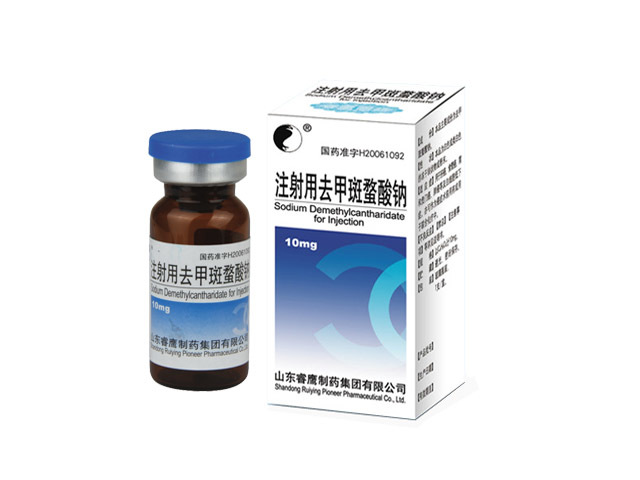Sodium Demethylcantharidate for Injection

Sodium Demethylcantharidate for Injection
English name: SodiumDemethylcantharidateforInjection
Chinese Pinyin: ZhusheyongQujiabamaosuanna
【 Ingredients 】 The main ingredient of this product is sodium norcantharidinate.
Chemical name: 1,2-cis-3,6-oxybridge-hexahydrophthalic acid sodium salt.
Molecular formula: C8H8O5Na2
Molecular weight: 230.14
Auxiliary material used: mannitol.
[Drug Name]
Common name: Sodium norcantharidinate for injection
English name: Sodium Demethylcantharidate for Injection
Chinese Pinyin: Zhusheyong Qujiabamaosuanna
Ingredients
The main ingredient of this product is sodium norcantharidinate.
Chemical name: 1,2-cis-3,6-oxybridge-hexahydrophthalic acid sodium salt.
Molecular formula: C8H8O5Na2
Molecular weight: 230.14
Auxiliary material used: mannitol.
【 Description 】 This product is a white or almost white freeze-dried block.
[Indications]
Used for liver cancer, esophageal cancer, gastric and cardia cancer, lung cancer, and leukopenia. It can also be used as a preoperative medication for cancer or in combination chemotherapy.
[Specification] 10mg
[Usage and Dosage]
1. Intravenous injection
Dissolve in an appropriate amount of sterilized injection water, then dilute with 5% glucose injection and slowly administer intravenously. Take 10-30mg once or as directed by a doctor. When intravenous infusion, dissolve in an appropriate amount of sterilized injection water and slowly add 5% glucose injection into 250-500ml.
2. Hepatic artery catheterization
Dissolve in an appropriate amount of sterilized injection water, 10-30mg once, twice a day. One month is one course of treatment, usually lasting 2-3 courses.
3. Intratumoral injection
Dissolve in an appropriate amount of sterilized injection water, 10-30mg once, once a week. Four times is one course of treatment, which can last for four consecutive courses.
Adverse reactions: If the injection dose exceeds 30mg, some patients may experience gastrointestinal symptoms such as nausea and vomiting.
[Taboo] It is prohibited for those who are allergic to this product.
【 Precautions 】
1. When administering intravenous medication, be careful to prevent the medication from leaking out of the blood vessel wall.
2. During intratumoral injection, prevent the medication from overflowing outside the tumor.
3. A small number of patients may experience an increase in body temperature when using this product. When using high doses, attention should be paid to changes in body temperature. If the body temperature rises, symptomatic treatment can be taken.
For patients with bleeding tendencies, higher doses should be used with caution.
Pregnant and lactating women should use medication under the guidance of a doctor and at their discretion.
【 Children's medication 】 The dosage for children should be reduced, generally 25% to 50% of the adult dosage, and can be used under the guidance of a doctor.
[Elderly medication] This experiment was not conducted and there are no reliable references available.
Drug interactions are not yet clear.
Drug overdose
Excessive medication may cause gastrointestinal reactions and damage to the heart, liver, and kidneys in some patients, and symptomatic treatment may be appropriate.
Pharmacology and Toxicology
This product has a destructive or inhibitory effect on the morphology or proliferation of cell lines such as liver cancer, esophageal cancer, laryngeal cancer, lung cancer, cervical cancer, etc. in vitro experiments. In vivo experiments have shown certain inhibitory effects on Ehrlich ascites carcinoma, sarcoma-180, and solid liver cancer in mice. It can improve the respiratory control rate and lysosomal enzyme activity of mitochondria in H22 ascites liver cancer mice, interfere with cancer cell division, block in the M phase, and affect its cycle running speed. This product can disrupt the cytoskeleton (microfilaments, microtubules) of cancer cells, affect the ultrastructure of cancer cells, and cause damage to mitochondria, microvilli, and plasma membrane. It can inhibit DNA synthesis in cancer cells, but does not inhibit normal bone marrow cells and can increase white blood cells.
Pharmacokinetics
After intravenous injection into animals, this product can be quickly distributed in various tissues and has high drug concentrations in liver, kidney, lung, stomach, intestine, heart, salivary glands, thyroid, and cancer tissues; The blood drug concentration decreases by half in about half an hour and completely disappears within 24 hours; The drug concentration in the liver reaches its peak within 1 hour, decreases by half within 6 hours, and completely disappears within 24 hours; The drug is mainly excreted through the urinary system. After intravenous injection, the drug concentration in the urine reaches its peak within 0.5-1 hours, and most of it is excreted from the urine within 24 hours.
【 Storage 】 Store in a cool and dry place, shaded and sealed.
【 Packaging 】 Glass bottle, 1 piece/box.
【 Validity 】 24 months.
[Executive Standard] YBH14442006
[Approval Number] National Pharmaceutical Approval Letter H20061092


